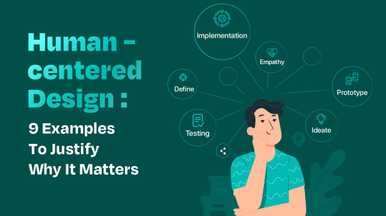Quantitative and Qualitative Usability Testing is an excellent aid in usability analysis. Data collected through both methodologies shed a lot of light on user interaction. Before we dig deep into the subject if you think that the hassle of Usability testing is too much, here are some latest stats to prove otherwise.
- More than 50% of consumers say they won’t even consider buying from a company if its mobile site is poorly designed.
- If a consumer has a negative experience, they are 88% less likely to return.
- Companies may anticipate a return on investment (ROI) of $2 to $100 for every $1 they put into user experience design.
What is Usability?
The success of a product depends on the satisfaction level of the end-user/customers. This is true for every product and every market. Though the producers strive to provide the ultimate satisfaction or user experience to the customers, how do they foresee how successful a product is going to be?
The only way to predict usability is to conduct usability testing and modify the product based on the test reports before releasing it to the target market.
By definition, usability testing is evaluating or assessing a product or service by actual users. Often it is also used or conducted to gather data on users. But what happens during a typical usability test?
People who design a product have different thoughts and languages than those who use it. While both groups may use the goods, the context in which they are being used is vastly different. When designing something, it’s essential to take a step back, put the user at the center, and test all assumptions in real time.
Usability is a measure of how well a user in a specific setting can use a product or design to reach a goal or objective that has been set. The usability of a plan works when its features meet the needs of the people who will be using it.
The only way to know if a product will be easy to use is to test it and make changes based on the results before putting it on the market.
Usability is when your product or design:
- Useful
- Learnable
- Memorable
- Effective and efficient
- Desirable
- Delightful
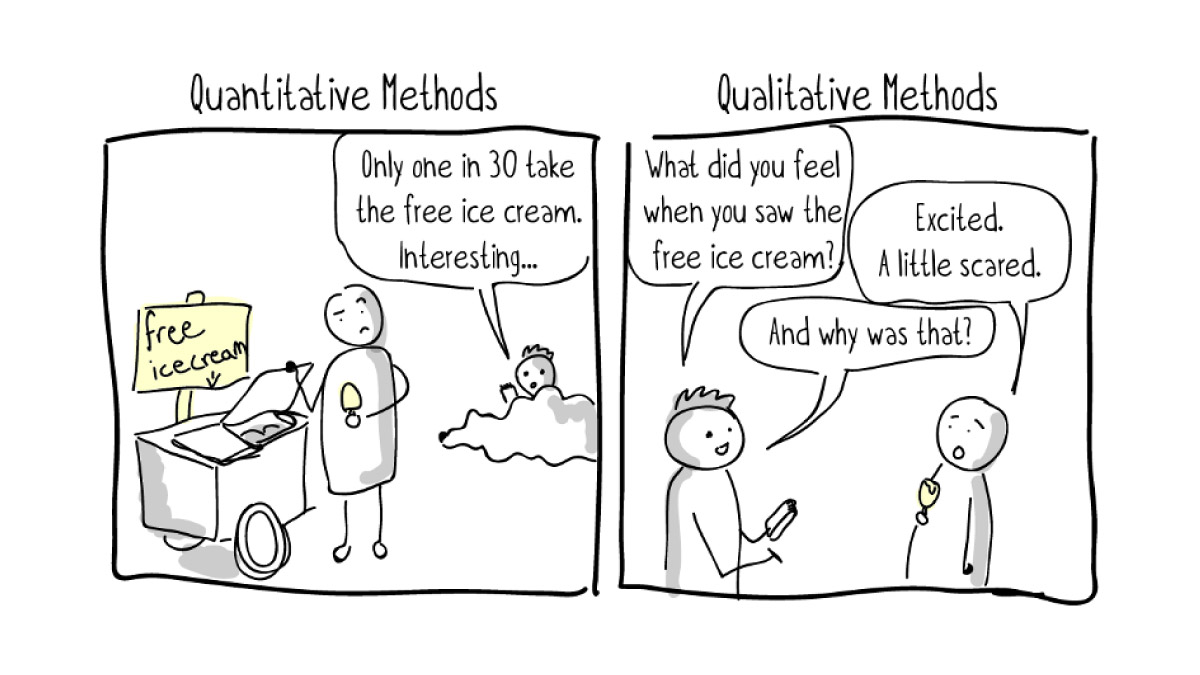
Source: Matt P Lavoie
What is Usability testing?
Usability testing measures how well a product or service works by talking to people who use it in real-time. Often, it’s used or conducted to gather data on users. But what happens during a typical usability test?
During a typical usability test, the evaluators will try to complete tasks or accomplish a target with the test product, and they will be observed and recorded by observers or people who are conducting the test. The data are collected through both quantitative and qualitative processes and analyzed.
So, usability tests are not only to get information about the product and how well it works but also to guide the user’s ability to perform or how efficiently they can do it.It’s essential to have a plan in place when conducting usability tests to ensure that the results are consistent and reliable.
Choosing the best usability testing methods depends on several factors, including:
- What do you want to achieve from the usability tests (UX research goals)
- How much time and money can you invest (available resources)
- Target audience ( user research participants and testers)
Goals of Usability Testing
Usability testing’s primary goal is to ensure that products and services are easy to use.
To identify issues and get user feedback
The primary objective of the tests is to identify, prioritize, and resolve usability issues. These are the most common testing objectives.
To compare against a benchmark
Benchmarks are reference points that make measurements more meaningful. Just like any other process that involves comparison,
To compare against an Interface
The third goal of the usability testing process is to compare two or more interfaces directly. Enterprise software interfaces can range from physical products to websites to mobile applications.
The comparison could also be with a previous study where the objective was to compare against a standard or benchmark.
Usability Testing Methodologies
Remote usability testing vs. In-person usability testing
Remote Usability Tests
Remote usability testing is conducted over the phone or the internet; it allows testing many people in various locations while using fewer resources. Remote usability testing includes two types: moderated and unmoderated.
In-person studies and remote (moderated) usability testing are fairly similar. The main distinction is that the facilitator and participant are not present in the same place; the observations will be made live via webcam.
In remote (unmoderated) usability tests, the researcher creates tasks for testing on a platform. The participants must read the instructions and do the tasks independently while being recorded. The participants must read the instructions and do the tasks independently while being recorded.
In-person testing
In-person testing requires the test to be administered by a UX researcher or facilitator. Researchers can look at body language and facial expressions in real-time during in-person tests, which gives them more information than remote tests. However, in-person testing is typically costly and time-consuming.
Quantitative vs. Qualitative Usability Testing
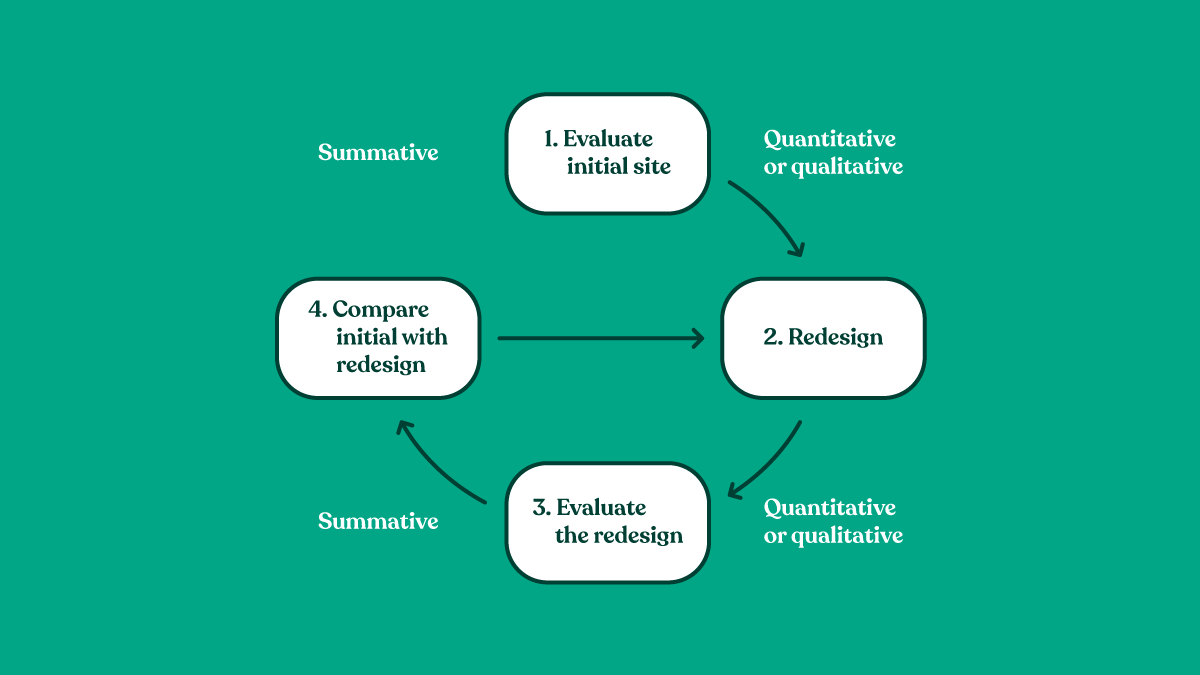
A usability-testing study involving users or participants assigned to perform one or more tasks can also be called a user-testing study. In such testing, two types of data are collected – qualitative and quantitative data. Qualitative and quantitative data are not generally collected simultaneously and require different study setups and analysis methods. But both are essential in the iterative design cycle. They should not be used interchangeably, and it is important to know when to use which type of study and why.
Though both forms of data are collected, user testing methods are more qualitative than quantitative.

#1 Nature of data
Qualitative data
This consists of observational data on user perceptions, opinions, and feelings. This kind of data offers a direct assessment of the system or the user. Observers can identify not only how hard or easy the tasks are but also the exact part of the task or design feature that is easy or hard. The observations can be augmented through the follow-up questionnaire.
Quantitative data
This data can be calculated or measured as the time taken to complete parts or tasks. This data offers an indirect assessment of the usability of a design or the users’ performance. Task completion time, the number of errors or success rates can only provide a perception of usability. A common example is satisfaction ratings for a product.
As quantitative data are only numbers, they are not used to interpret a usability testing study in absolute terms. They don’t tell about the problems that arose or suggest a modification to the design for better performance. This is also true from a user or performance point of view.
#2 When to conduct a Qualitative study
- A qualitative study answers ‘why, ‘how’ and ‘what’ like – ‘why did you stop…?’ ‘What happened…?”How did you feel…?’ As a qualitative study brings the user and the test team closer, a more personalized study can be conducted. There can be an actual conversation, and the team can gain useful user insight. These insights can be used to modify /better the design.
- To assess the performance of a participant in a user-testing study. The insights from the participant or the data can be put into context, and the performance can be evaluated more accurately.
- A situation where the participants or users are limited in number. A qualitative study can provide in-depth insights, but it requires fewer participants or users.
#3 When to conduct a Quantitative study
- This study throws light on group behavior but doesn’t discuss individual participants. It can identify the percentage of participants having a problem with a particular task but won’t tell the individual problems. This objective nature of data helps identify areas where things go wrong without talking about what went wrong.
- They are used to validate the usability of a larger project. For example, a payment app will require validation in user ratings and percentages.
- They require a greater number of users or participants as the data obtained is in the form of numbers or measurements. A larger user or participant group can provide a substantial figure to validate a study.
#4 Qualitative testing methods
Moderated vs. Unmoderated (mediated vs. unmediated) testing
A moderated or mediated test is a study based on direct interaction between the participant/user and the moderator. The moderator hears what the participant feels and thinks and probes more to get the detail out. There is a chance to observe and record participants’ body language and expressions while performing the task. The level of intervention can be at the moderator’s discretion. This kind of test is time-consuming and also requires skilled manpower.
Unmoderated or unmediated tests don’t require direct interaction and can be conducted on a larger group of users or participants. The users /participants are given certain tasks and are observed and recorded while completing the task with minimum interaction.
Tree Testing and Card Sorting
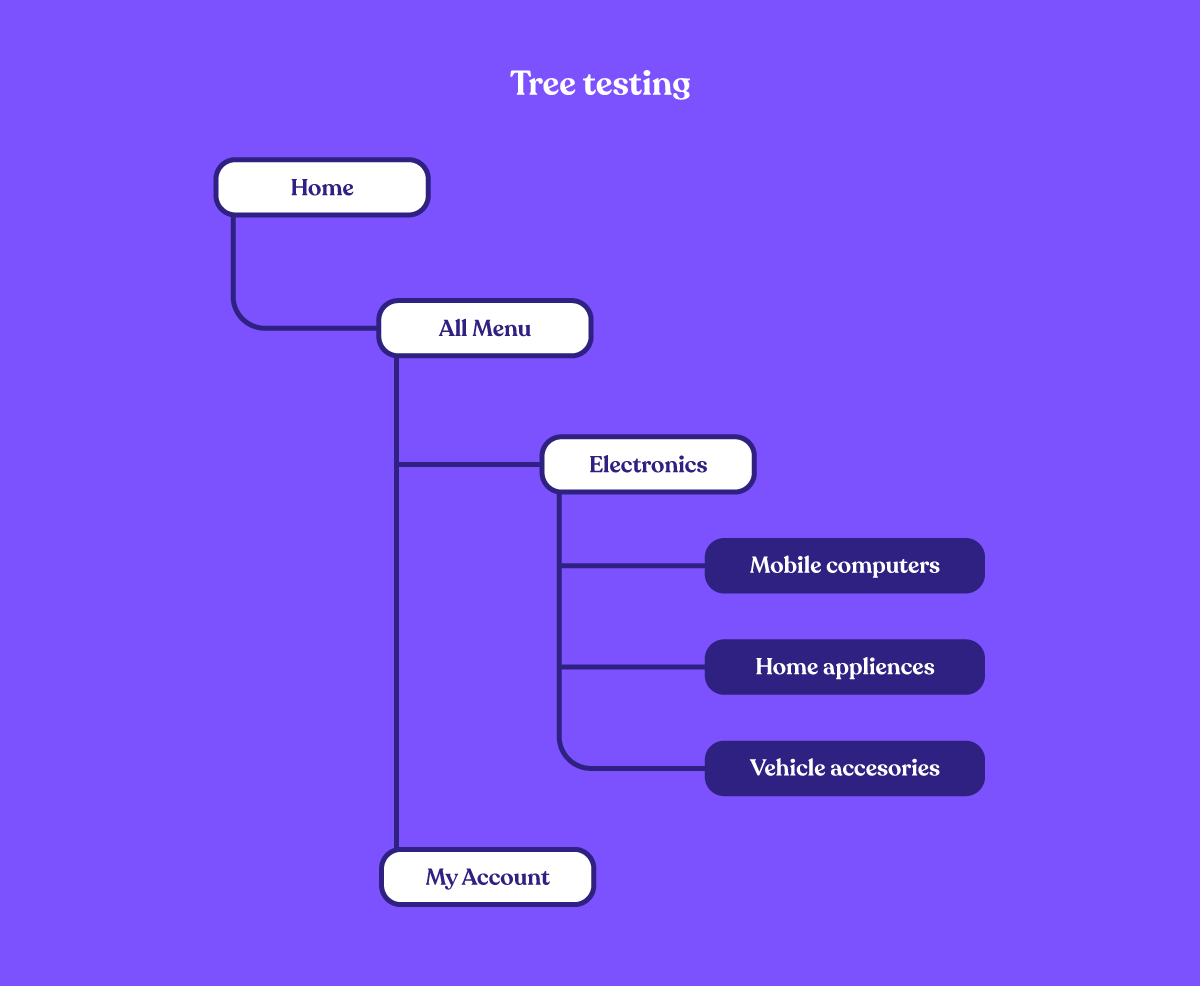
Tree Testing is used to assess the general logic of the structure of the product/service. The participants are presented with a simplified visual representation of the product architecture (usually in the form of a tree). They are then given an item representing a part or a piece of information and told to place it in the appropriate position (branches) of the logic tree.
The time spent or the doubt arising in labeling and sorting the information pieces are recorded and later analyzed. If the participants show greater confusion in categorizing a particular piece, that is red-flagged.
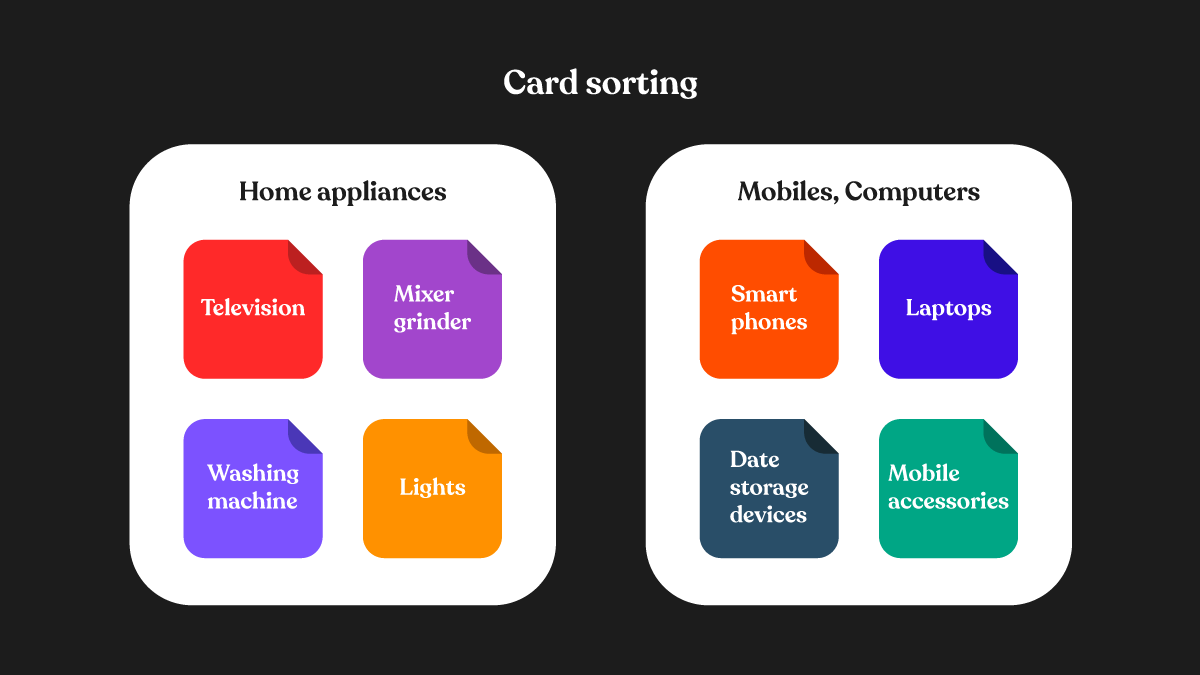
Card sorting is the opposite of tree testing. Here the participants are given a set of information and asked to create a logical structure.
This kind of test not only points to what kind of structure makes more sense but also to the user’s mental setup and reasoning abilities.
#5 Quantitative testing methods
A/B vs. Multivariate Testing
In A/B testing, the participants are presented with two versions of the same problem/ task and asked to complete them. It is a simple way to find out the right direction, but it works when there are very limited solutions.
Multivariate testing is essentially the same as A/B testing, but here instead of presenting two choices, several are presented at the same time. This is a practical way to narrow down choices.

Eye Tracking and Heatmaps
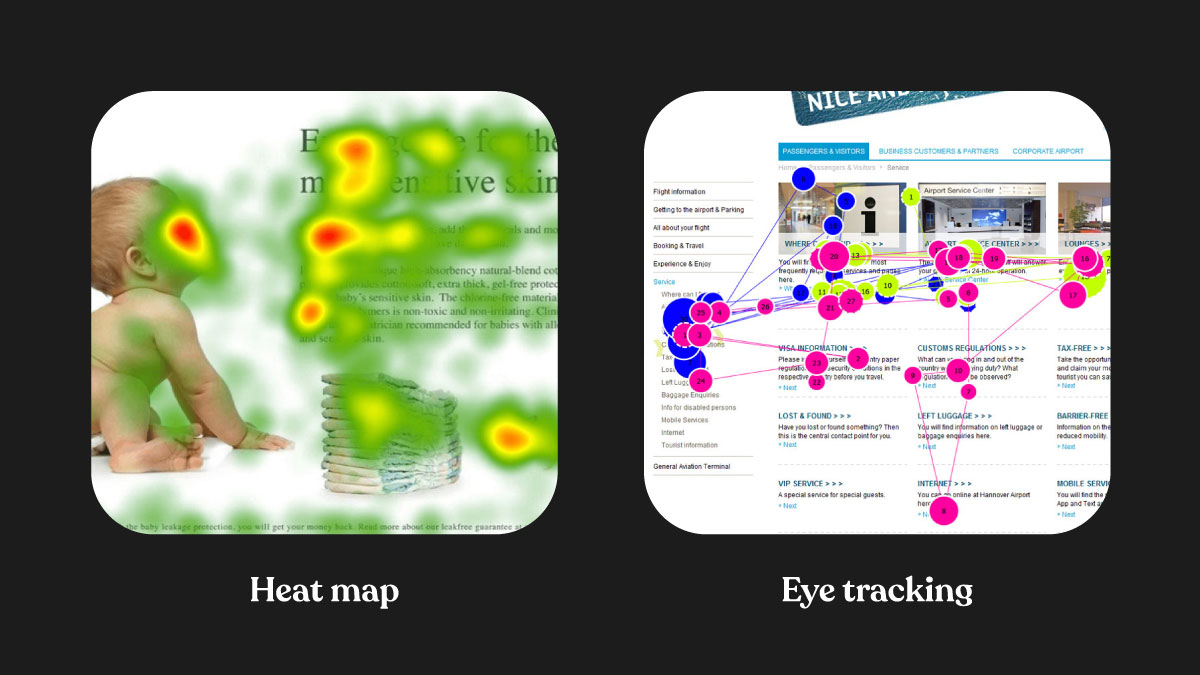
Eye Tracking is a powerful quantitative technique. This test identifies what a participant/user focuses on most. For example, when interacting with an interface, the participant is attracted to a particular component and stays on it for some time to process it completely. This movement can be tracked and measured to provide a trend or an understanding of the bigger picture. This works better when used and compared with similar prototype designs. Unlike Eye Tracking, Heatmaps point to those parts of the interface or design that the participants focus on the most. The quantitative data thus tell which parts of the design the participants found most interesting. Translation of the data makes a heat map pointing to all the hot areas in the design.
Lostness metric
It gives you insight into how well people can navigate your product and how well it was designed. In a range from 0 to 1, the lostness metric indicates how lost a person is. As a result, a design in which there is no lostness is considered to be highly efficient. On the other hand, a score of 1 indicates serious issues, and users will have no idea how to use your interface.

#6 Statistics in qualitative and quantitative studies
One significant advantage of quantitative studies over qualitative ones is the use of statistics. Since quantitative data is mostly numbers that can be measured, they can be presented in a more orderly way with the help of statistical tools.
When quantitative research is presented in this manner, it doesn’t seem random or biased. They help to see the trend/deviation among the users or participants from an objective point of view. They also help to summarize the findings in a more orderly manner and help to predict or point towards a hypothesis or negate it.
As qualitative data can be observed or heard, it is descriptive and can’t be represented through statistical tools. The qualitative data also cannot be assured as truly objective and represents the whole.
Tips for running an effective Usability Test
Usability testing is a key method of research that every user researcher should know how to do well. Here are five tips for running usability tests effectively:
- Before you start usability testing, establish and clarify the research objectives with stakeholders.
- Prepare a list of follow-up questions that will assist you in redirecting the conversation.
- Plan and design the entire usability testing session, from the introduction to the conclusion. Creating a script would help you through the process and provide vital insights.
- Utilize customized solutions that simplify the process of user research and testing sessions. You may record all your notes in one place as opposed to on paper.
- It is preferable to include other researchers in testing sessions.
Conclusion
When testing a UX design or app, both qualitative and quantitative research can be used to find the product’s flaws, which can then be fixed or removed.
User experience, Qualitative studies are more direct because they look at how things work and how people feel about them. It is a useful tool for figuring out the main usability problems in a product’s design and making the changes that are needed.
Quantitative studies, on the other hand, although they are not direct, offer a summary evaluation and point in a clear direction. It is important to understand the strengths and weaknesses of both methods and, more importantly, to know when to use a particular method.
It’s important to understand the goals of both types of testing, which show how important it is to test constantly and in small steps. User experience research is a continuous process of learning and getting better. To get the most out of it, it should be done in cycles.






